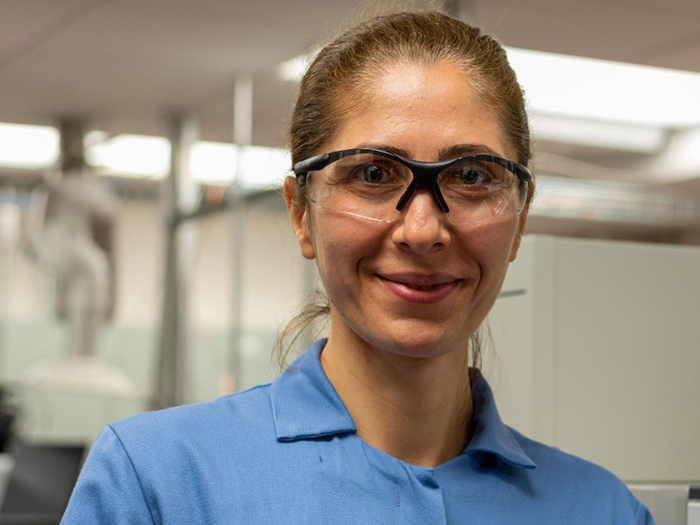Turning plastic waste into useful products through chemical recycling is one strategy for addressing Earth’s growing plastic pollution problem. A new study may improve the ability of one method, called pyrolysis, to process hard-to-recycle mixed plastics — like multilayer food packaging — and generate fuel as a byproduct, the scientists said.

Credit: Penn State University
Turning plastic waste into useful products through chemical recycling is one strategy for addressing Earth’s growing plastic pollution problem. A new study may improve the ability of one method, called pyrolysis, to process hard-to-recycle mixed plastics — like multilayer food packaging — and generate fuel as a byproduct, the scientists said.
Pyrolysis involves heating plastic in an oxygen-free environment, causing the materials to break down and creating new liquid or gas fuels in the process. Current commercial applications, however, either operate below the necessary scale or can only handle certain type of plastics, the scientists said.
“We have a very limited understanding of mixed-plastic pyrolysis,” said Hilal Ezgi Toraman, assistant professor of energy engineering and chemical engineering at Penn State. “Understanding the interaction effects between different polymers during advanced recycling is very important while we are trying to develop technologies that can recycle real waste plastics.”
The scientists conducted co-pyrolysis of two of the most common types of plastic, low-density polyethylene (LDPE) and polyethylene terephthalate (PET), along with different catalysts to study the interaction effects between the plastics. They found one catalyst may be a good candidate for converting mixed LDPE and PET waste into valuable liquid fuels. Catalysts are materials added to pyrolysis that can aid the process, like inducing the plastic to break down selectively and at lower temperatures.
“This type of work can allow us to provide guidelines or suggestions to industry,” said Toraman, who is the Virginia S. and Philip L. Walker Jr. Faculty Fellow in the John and Willie Leone Family Department of Energy and Mineral Engineering at Penn State. “It’s important to discover what kind of synergies exist between these materials during advanced recycling and what types of applications they may be right for before scaling up.”
The plastics, LDPE and PET, are commonly found in food packaging, which often consists of layers of different plastic material that are engineered to keep products fresh and safe, but are also difficult to recycle with traditional processes because the layers have to be separated, which is an expensive process.
“If you want to recycle them, you need to basically separate those layers and maybe do something with the single streams,” Toraman said. “But pyrolysis can handle it, so it’s a very important option. It’s not easy to find such a technique that can accept that messy complexity of the these different plastic materials.”
The first step to developing new commercial pyrolysis processes hinges on having a better mechanistic understanding of how dynamic plastic waste mixtures decompose and interact, the scientists said.
The scientists conducted pyrolysis on LDPE and PET separately and together and observed interaction effects between the two polymers during tests with each of three catalysts they used. The scientists reported the findings in the journal Reaction Chemistry & Engineering.
“We saw products that can be very good candidates for gasoline application,” Toraman said.
The team also developed a kinetic model that was able to accurately model the interaction effects observed during co-pyrolysis of LDPE and PET with each of the catalysts. Kinetic models attempt to predict the behavior of a system and are important for better understanding why reactions are occurring.
Toraman’s research group focuses on doing experiments under well-defined and well-controlled conditions to understand interaction effects during advanced recycling of mixed plastics and the corresponding reaction mechanisms.
“Systematic and fundamental studies on understanding reaction pathways and developing kinetic models are the first steps toward process optimization,” Toraman said. “If we don’t have our kinetic models right, our reaction mechanisms accurately, then if we scale up for pilot plants or large-scale operations, the results won’t be accurate.”
Toraman said she hopes the research leads to better environmental responsibility in the recovery, processing and utilization of Earth resources.
A global analysis of all mass-produced plastics found that a total of 8.3 billion metric tons of new plastics is estimated to be generated worldwide to date. As of 2015, 79% of plastic waste, which contains numerous hazardous chemicals, has been left to accumulate in landfills or natural environments with approximately 12% incinerated and only 9% recycled.
“Whatever we do is better than doing nothing,” Toraman said. “We need to include those plastics into the economy again, to have a circular economy, otherwise they will just end up in landfills, leaching potentially toxic substances into the soil and water or contaminate oceans. So doing something, finding a value, is better than nothing. Plastics are currently considered as waste because we treat these valuable resources as waste.”
Other Penn State researchers on this project were Sean Timothy Okonsky, doctoral student in the Department of Chemical Engineering, and J.V. Jayarama Krishna, postdoctoral researcher in the John and Willie Leone Family Department of Energy and Mineral Engineering.
The work stems from a $3.4 million grant Penn State received from the REMADE Institute, a public-private partnership established by the United States Department of Energy, to fund research targeting the inefficient methods currently used to process and upcycle mixed plastic waste.
The DOE’s Office of Energy Efficiency and Renewable Energy and a Penn State Energy and Environmental Sustainability Laboratory Green award also supported this work.
Journal
Reaction Chemistry & Engineering
DOI
10.1039/D2RE00144F
Method of Research
Experimental study
Subject of Research
Not applicable
Article Title
Catalytic co-pyrolysis of LDPE and PET with HZSM-5, H-beta, and HY: Experiments and kinetic modelling
Article Publication Date
30-Jun-2022




